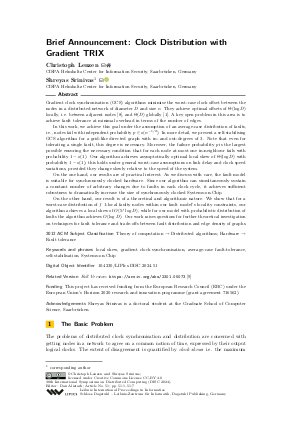Brief Announcement: Clock Distribution with Gradient TRIX
Authors
Christoph Lenzen,
Shreyas Srinivas 
-
Part of:
Volume:
38th International Symposium on Distributed Computing (DISC 2024)
Part of: Series: Leibniz International Proceedings in Informatics (LIPIcs)
Part of: Conference: International Symposium on Distributed Computing (DISC) - License:
 Creative Commons Attribution 4.0 International license
Creative Commons Attribution 4.0 International license
- Publication Date: 2024-10-24
File

PDF
LIPIcs.DISC.2024.51.pdf
- Filesize: 0.66 MB
- 7 pages
Document Identifiers
Related Versions
- Full Version https://arxiv.org/abs/2301.05073
Subject Classification
ACM Subject Classification
- Theory of computation → Distributed algorithms
- Hardware → Fault tolerance
Keywords
- local skew
- gradient clock synchronisation
- average-case fault-tolerance
- self-stabilisation
- Systems-on-Chip
Metrics
- Access Statistics
-
Total Accesses (updated on a weekly basis)
0PDF Downloads0Metadata Views
Abstract
Gradient clock synchronisation (GCS) algorithms minimise the worst-case clock offset between the nodes in a distributed network of diameter D and size n. They achieve optimal offsets of Θ(log D) locally, i.e. between adjacent nodes [Lenzen et al., 2010], and Θ(D) globally [Biaz and Welch, 2001]. A key open problem in this area is to achieve fault tolerance at minimal overhead in terms of the number of edges.
In this work, we achieve this goal under the assumption of an average-case distribution of faults, i.e., nodes fail with independent probability p ∈ o(n^{-1/2}). In more detail, we present a self-stabilising GCS algorithm for a grid-like directed graph with in- and out-degrees of 3. Note that even for tolerating a single fault, this degree is necessary. Moreover, the failure probability p is the largest possible ensuring the necessary condition that for each node at most one in-neighbour fails with probability 1-o(1). Our algorithm achieves asymptotically optimal local skew of Θ(log D) with probability 1-o(1); this holds under general worst-case assumptions on link delay and clock speed variations, provided they change slowly relative to the speed of the system.
On the one hand, our results are of practical interest. As we discuss with care, the fault model is suitable for synchronously clocked hardware. Since our algorithm can simultaneously sustain a constant number of arbitrary changes due to faults in each clock cycle, it achieves sufficient robustness to dramatically increase the size of synchronously clocked Systems-on-Chip.
On the other hand, our result is of a theoretical and algorithmic nature. We show that for a worst-case distribution of f 1-local faulty nodes within our fault model’s locality constraints, our algorithm achieves a local skew of O(5^flog D), while for our model with probabilistic distribution of faults the algorithm achieves O(log D). Our work raises questions for further theoretical investigation on techniques for fault tolerance and trade-offs between fault distribution and edge density of graphs.
Cite As Get BibTex
Christoph Lenzen and Shreyas Srinivas. Brief Announcement: Clock Distribution with Gradient TRIX. In 38th International Symposium on Distributed Computing (DISC 2024). Leibniz International Proceedings in Informatics (LIPIcs), Volume 319, pp. 51:1-51:7, Schloss Dagstuhl – Leibniz-Zentrum für Informatik (2024)
https://doi.org/10.4230/LIPIcs.DISC.2024.51
BibTex
@InProceedings{lenzen_et_al:LIPIcs.DISC.2024.51,
author = {Lenzen, Christoph and Srinivas, Shreyas},
title = {{Brief Announcement: Clock Distribution with Gradient TRIX}},
booktitle = {38th International Symposium on Distributed Computing (DISC 2024)},
pages = {51:1--51:7},
series = {Leibniz International Proceedings in Informatics (LIPIcs)},
ISBN = {978-3-95977-352-2},
ISSN = {1868-8969},
year = {2024},
volume = {319},
editor = {Alistarh, Dan},
publisher = {Schloss Dagstuhl -- Leibniz-Zentrum f{\"u}r Informatik},
address = {Dagstuhl, Germany},
URL = {https://drops.dagstuhl.de/entities/document/10.4230/LIPIcs.DISC.2024.51},
URN = {urn:nbn:de:0030-drops-212791},
doi = {10.4230/LIPIcs.DISC.2024.51},
annote = {Keywords: local skew, gradient clock synchronisation, average-case fault-tolerance, self-stabilisation, Systems-on-Chip}
}
Author Details
Funding
This project has received funding from the European Research Council (ERC) under the European Union’s Horizon 2020 research and innovation programme (grant agreement 716562).
Acknowledgements
Shreyas Srinivas is a doctoral student at the Graduate School of Computer Science, Saarbrücken.
References
- Saâd Biaz and Jennifer Lundelius Welch. Closed Form Bounds for Clock Synchronization under Simple Uncertainty Assumptions. Information Processing Letters, 80:151-157, 2001. URL: https://doi.org/10.1016/S0020-0190(01)00151-X.
- Johannes Bund, Christoph Lenzen, and Will Rosenbaum. Fault Tolerant Gradient Clock Synchronization. In Proceedings of the 2019 ACM Symposium on Principles of Distributed Computing, PODC 2019, Toronto, ON, Canada, July 29 - August 2, 2019, pages 357-365, 2019. URL: https://doi.org/10.1145/3293611.3331637.
- Danny Dolev, Matthias Függer, Christoph Lenzen, Martin Perner, and Ulrich Schmid. HEX: Scaling honeycombs is easier than scaling clock trees. Journal of Computer and System Sciences, 82(5):929-956, 2016. URL: https://doi.org/10.1016/j.jcss.2016.03.001.
- Rui Fan and Nancy Lynch. Gradient Clock Synchronization. In Symposium on Principles of Distributed Computing (PODC), pages 320-327, 2004. URL: https://doi.org/10.1145/1011767.1011815.
-
David Harris and N Weste. Cmos vlsi design. ed: Pearson Education, Inc, 2010.

-
Pankaj Khanchandani and Christoph Lenzen. Self-Stabilizing Byzantine Clock Synchronization with Optimal Precision. Theory of Computing Systems, 2018.

- Christoph Lenzen, Thomas Locher, and Roger Wattenhofer. Clock Synchronization with Bounded Global and Local Skew. In Symposium on Foundations of Computer Science (FOCS), pages 509-518, 2008. URL: https://doi.org/10.1109/FOCS.2008.10.
- Christoph Lenzen, Thomas Locher, and Roger Wattenhofer. Tight Bounds for Clock Synchronization. J. ACM, 57(2), 2010. URL: https://doi.org/10.1145/1667053.1667057.
- Christoph Lenzen and Shreyas Srinivas. Gradient trix, 2023. https://arxiv.org/abs/2301.05073, URL: https://doi.org/10.48550/arXiv.2301.05073.
- Christoph Lenzen and Ben Wiederhake. TRIX: Low-Skew Pulse Propagation for Fault-Tolerant Hardware, 2020. URL: https://arxiv.org/abs/2010.01415.
- Jennifer Lundelius Welch and Nancy A. Lynch. A New Fault-Tolerant Algorithm for Clock Synchronization. Information and Computation, 77(1):1-36, 1988. URL: https://doi.org/10.1016/0890-5401(88)90043-0.
